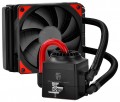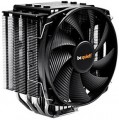Product type
—
Fan. Classic fan — a motor with blades that provides air flow; it also includes multi-fan kits. Anyway, you should not confuse such devices with coolers (see below) — fans do not have heatsinks. Almost all solutions of this type are designed for enclosures (see "Intended use"), only a few models are designed for "blowing" hard drives or chipsets.
—
Radiator. Thermally conductive material construction with a special ribbed shape. This shape provides a large area of contact with air, as a result — good heat transfer. Radiators do not consume energy and operate absolutely silently, but they are not very efficient. Therefore, they are extremely rare in their pure form, and such models are intended either for low-power PC components with low heat dissipation (energy-efficient processors, hard drives, etc.), or for assembling an active cooler (see below) from a separately purchased fan and radiator (this option is found among solutions for video cards).
—
Active cooler. A device in the form of a radiator with a fan installed on it; however, in many models, the heatsink does not directly contact the cooled component, but is connected to it using heat pipes, while air is blown sideways (the so-called tower layout, especially popular in systems for the CPU; for more details, see "Blowing the air flow") . Anyway, such designs are, on the one hand, relatively simp
...le and inexpensive, and, on the other hand, quite effective, which makes them an extremely popular type of Cooling system. In particular, it is in this format that most solutions for CPUs are produced (see "Intended use"), and in general coolers can be used for almost any component of the system, except for the case.
— Water cooling. Water cooling systems consist of three main parts: a water block in direct contact with the cooled component (usually a processor), an external cooler, and a pump (separate or built into the cooler). These components are connected by hoses through which water (or other similar coolant) circulates — it provides heat transfer. And the cooling block is usually a cooler — a system of fans and heatsinks that dissipates heat energy into the surrounding air. Water systems are noticeably more efficient than active coolers (see above), they are suitable even for very powerful and "hot" CPUs, which traditional coolers can hardly cope with. On the other hand, this type of cooling is quite bulky and difficult to install, and it is not cheap.
— A set of LSS. Kit for self-assembly of liquid (water) cooling system. The difference between such solutions and conventional water cooling (see above) lies in the fact that in this case the entire system is supplied as a set of parts, from which the user must assemble the finished coolant himself (whereas in traditional water systems, the matter is usually limited to connecting hoses and filling coolant). Such a format significantly expands the user's options in terms of installation: you can independently choose individual layout nuances, replace some regular parts, supplement the design with third-party elements, etc. On the other hand, the installation itself turns out to be much more complex than traditional water systems. Therefore, very few LSS kits are produced, and they are designed mainly for enthusiast modders who like to experiment with the design and construction of their PCs.
— backplate. A solid metal plate used as a fastener for the cooling system. Serves to prevent the motherboard or video card from bending when deploying a heat dissipation system, and also provides passive cooling for the rear side of those modules with which it is adjacent.
- Water block VRM. A water block that provides efficient cooling of the elements of the VRM (Voltage Regulator Module) CPU power subsystem.
- CPU waterblock. Heat exchanger made of copper or nickel, designed to remove heat from the CPU through the coolant. Used in computer water cooling systems. Most often, processor water blocks are supplied with mounts for certain processor platforms.
- GPU water block. Liquid cooling blocks for the most efficient heat removal from the video card. Similar solutions are produced for a specific group of video cards on a single GPU. GPU water blocks consist of two main parts: the upper one, where a copper alloy heat sink is located, a plastic overlay with liquid channels and a casing to stiffen the structure, as well as a metal plate at the bottom of the block on the reverse side of the printed circuit board.
— A set of fasteners. A set of fasteners for mounting cooling systems on computer motherboard elements. Issued for specific socket versions.Fan size
The diameter of the fan(s) used in the cooling system.
In general, larger fans are considered more advanced than smaller ones: they allow you to create a powerful air flow at a relatively low speed and low noise level. On the other hand, a large diameter means large dimensions, weight and price. As for specific figures,
40 mm and
60 mm models are considered miniature,
80 mm and
92 mm are medium,
120 mm and
135 /
140 mm are large, and even
200 mm fans are found in the most powerful
case systems.
Min. RPM
The lowest speed at which the cooling fan is capable of operating. Specified only for models with speed control (see below).
The lower the minimum speed (with the same maximum) — the wider the speed control range and the more you can slow down the fan when high performance is not needed (such a slowdown allows you to reduce energy consumption and noise level). On the other hand, an extensive range affects the cost accordingly.
Max. RPM
The highest speed at which the cooling system fan is capable of operating; for models without a speed controller (see below), this item indicates the nominal rotation speed. In the "slowest" modern fans, the maximum speed
does not exceed 1000 rpm, in the "fastest" it can be up
to 2500 rpm and even
more.
Note that this parameter is closely related to the fan diameter (see above): the smaller the diameter, the higher the speed must be to achieve the desired airflow values. In this case, the rotation speed directly affects the level of noise and vibration. Therefore, it is believed that the required volume of air is best provided by large and relatively "slow" fans; and it makes sense to use "fast" small models where compactness is crucial. If we compare the speed of models of the same size, then higher speeds have a positive effect on performance, but increase not only the noise level, but also the price and power consumption.
Max. air flow
The maximum airflow that a cooling fan can create; measured in CFM — cubic feet per minute.
The higher the CFM number, the more efficient the fan. On the other hand, high performance requires either a large diameter (which affects the size and cost) or high speed (which increases the noise and vibration levels). Therefore, when choosing, it makes sense not to chase the maximum air flow, but to use special formulas that allow you to calculate the required number of CFM depending on the type and power of the cooled component and other parameters. Such formulas can be found in special sources. As for specific numbers, in the most modest systems, the performance
does not exceed 30 CFM, and in the most powerful systems it can be up to 80 CFM and even
more.
It is also worth considering that the actual value of the air flow at the highest speed is usually lower than the claimed maximum; see Static Pressure for details.
Static pressure
The maximum static air pressure generated by the fan during operation.
This parameter is measured as follows: if the fan is installed on a blind pipe, from which there is no air outlet, and turned on for blowing, then the pressure reached in the pipe will correspond to the static one. In fact, this parameter determines the overall efficiency of the fan: the higher the static pressure (ceteris paribus), the easier it is for the fan to “push” the required amount of air through a space with high resistance, for example, through narrow slots of a radiator or through a case full of components.
Also, this parameter is used for some specific calculations, however, these calculations are quite complex and, usually, are not necessary for an ordinary user — they are associated with nuances that are relevant mainly for computer enthusiasts. You can read more about this in special sources.
MTBF
The total time that a cooling fan is guaranteed to run before it fails. Note that when this time is exhausted, the device will not necessarily break — many modern fans have a significant margin of safety and are able to work for some more period. At the same time, it is worth evaluating the overall durability of the cooling system according to this parameter.
Max. TDP
The maximum TDP provided by the cooling system. Note that this parameter is indicated only for solutions equipped with heatsinks (see "Type"); for separately made fans, the efficiency is determined by other parameters, primarily by the air flow values (see above).
TDP can be described as the amount of heat that a cooling system is able to remove from a serviced component. Accordingly, for the normal operation of the entire system, it is necessary that the TDP of the cooling system is not lower than the heat dissipation of this component (heat dissipation data is usually indicated in the detailed characteristics of the components). And it is best to select coolers with a power margin of at least 20 – 25% — this will give an additional guarantee in case of forced operation modes and emergency situations (including clogging of the case and reduced air exchange efficiency).
As for specific numbers, the most modest modern cooling systems provide TDP
up to 100 W, the most advanced —
up to 250 W and even
higher.
Lighting
The presence
of its own illumination in the design of the cooling system.
The backlight serves a purely aesthetic function — it gives the device a stylish appearance that blends well with other components in the original design. Thanks to this, such cooling systems are especially appreciated by gamers and fans of external PC modding — especially since the lighting can be different, and the most advanced models even provide backlight synchronization with other components (see below). On the other hand, this function does not affect the efficiency and performance, and the overall cost is inevitably affected, sometimes quite noticeably. Therefore, if the appearance does not play a fundamental role for you, the best choice, most likely, will be
a cooling system without backlight.

